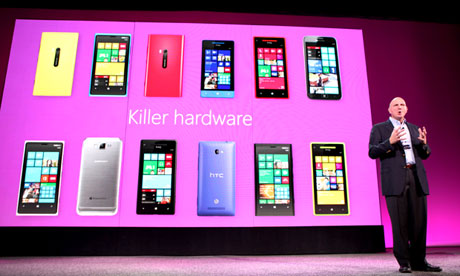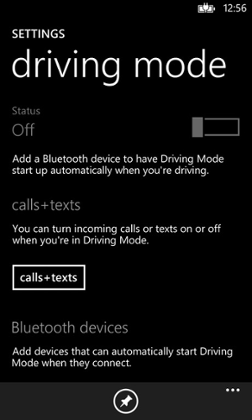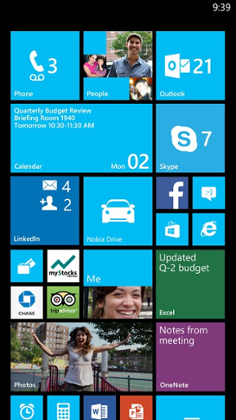Microsoft is updating Windows Phone 8 for the third time, adding in a Driving mode and making provisions for future 'phablet' devices
Microsoft CEO Steve Ballmer launches Windows Phone 8 in 2012 Photograph: Kimihiro Hoshino/AFP/Getty Images
Microsoft is updating its Windows Phone software to accommodate larger devices of up to 6in diagonally - classed as a "phablet" (phone-tablet) - and make it easier for motorists to reduce distractions while driving.
The move is part of an effort to give its range of mobile devices greater feature parity with Apple's iPhone and Google's Android, even while it lags in sales behind the two ecosystems.
It's the third update to the Windows Phone 8 software since the system's release a year ago. Devices with this update will start appearing in the coming weeks, and older phones will be eligible for a free upgrade, too. Microsoft couldn't give a precise date when the software will be sent to older handsets, because that will depend on operators' approval.
DRIVE TIME
Something that may appeal to motorists: a new Driving Mode will automatically silence incoming calls and texts so that you can focus on the road. You also can configure the feature to automatically send out a reply to say that you're driving. It can be activated automatically when the phone is linked wirelessly with a Bluetooth device in the car, such as a headset. Apple has a Do Not Disturb feature for iPhones, which can be activated via its Siri voice assistant.
What the Driving Mode won't do, however, is block outgoing calls or texts. And there will be ways to override it. The feature won't stop a teenager from texting while driving, but it will help reduce distractions for those who want that, says Greg Sullivan, director for Microsoft's Windows Phone business.

In a blog post about the update, Darren Laybourn, the corporate vice-president for Windows phone points to a number of enhancements, including a rotation lock for the screen ("does your screen keep spinning when you're trying to read emails in bed?"), an easy way to close apps from the multitasking interface, Wi-Fi access when configuring a new phone, and improved Bluetooth. All of those bring Windows Phone closer to feature parity with Apple's iPhone and Google's Android - although there is still no solution for Microsoft's longstanding row with Google over a native app to show YouTube videos.
PHABLET TIME
The new update also will allow for better resolution to accommodate larger phones. Currently, the system supports a maximum resolution of 1280 pixels by 768 pixels, which is adequate for phones with screens no larger than 5in on the diagonal. But video and image quality degrades when stretched out on larger phones, such as a 6.3in (16-centimeter) Samsung Galaxy Mega, one of the largest phablets on sale.

The layout for larger phones also will change. Phones may now sport a third column of tiles, for instance; previously they have been restricted to two, although some have allowed small icons to fit more in. Contact lists and other features will be able to fit in more information. That's a contrast to Android, where larger screens means that text and images simply gets bigger, without actually fitting in more content.
Microsoft's Windows Phone software, launched in October 2010, holds a distant third place behind Apple's iOS and Google's Android. It had a worldwide market share of 3.7% in the second quarter, according to research firm IDC. But shipments of Windows Phone devices grew 78% to 8.7m in the April-to-June period, compared with the same time a year ago. In the five largest European countries, its share of sales in the quarter to the end of September approached 10%, hitting 12% in the UK.
Microsoft in September said it is buying the mobile handset division of Nokia, the Finnish company, and will close the deal in the new year. That may mean that it can drive development of the software and hardware together - though it will still be licensing the software to companies including ZTE, Samsung and HTC - the latter having less than 10% of Windows Phone sales, yet still being the biggest provider outside Nokia.
Microsoft is launching a program to give app developers early access to the new software. Apple has had a similar program for the iOS software behind iPhones and iPads, while Google often has worked with selected developers on unreleased features.
source: the guardian.
source: the guardian.
